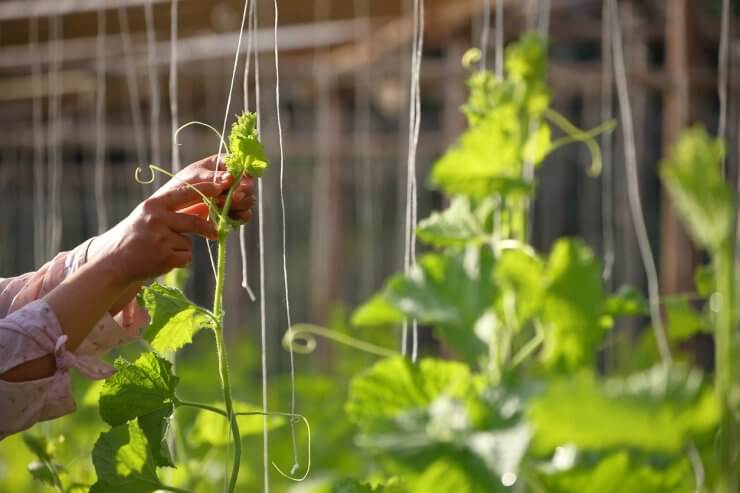
Gardener helps squash vine plant to climb up the string in vegetable garden.
Some squash, like butternut, send out long vines before they develop flower buds. Those vines can grow pretty long—longer than you expect, perhaps. The main vines will send off secondary vines and those vines will send off vines of their own. At some point, you need to bring things under control. You can let them stretch out and roam your garden—if you have the space. Another way to keep things under control is to provide sturdy trellises for your squash to climb on.
The vines—and their broad leaves—are the energy center of your squash plant; without the leaves to produce energy, your squash would never develop. However, you can have too much of a good thing. So, even if it looks like your squash plant is being wildly prolific, keep in mind that most vining squash plants only produce four or five fruits per plant; more than that, and the plant won’t have enough energy to support the development of more fruits.
How to prune your squash
Once you have your four or five fruits set (check your seed packets for exactly what to expect from the variety you’re growing), feel free to start pruning. If you start pruning then, the vines will still be tender enough that you can probably prune the vines by pinching them off with your fingers (there’s also a cool fingertip cutting tool you can use). Look for the squash that’s farthest out on the vine and pinch off the top of the vine. Leave a couple leaf nodes past the last squash on that vine that you’re still growing.
Continue pruning other vines so you end up with just the four or five that the plant can support.
How to support your squash
Speaking of support … as your squash grows, it’s going to need a little support—whether you’re letting the vines spread out on the ground, or you’re using some sort of strong trellis. The key here is to keep the squash off the ground, away from excess moisture and pesky insects. If you have squash growing on a vine that’s been climbing the trellis you so nicely provided, a little extra support would be in order. That can be something as simple as some old panty hose tied like a little hammock underneath the squash. Be sure to leave enough slack so that as the squash grows, the sling can stretch to accommodate it.
If your squash is growing on the ground (or in a raised bed, or spilling out of a container), you can use a wooden board to rest your squash on. Some garden centers sell special cradles that let you rest your growing squash on a pedestal to keep it up off the ground, nice and dry—and less likely to develop mildew.
You can also provide a trellis of some sort to let your squash vines grow upward. Strong wooden trellises work well. You can even get a panel of cattle fencing; it’s very strong and will support your growing plants. Just be sure to provide some cradle/hammock space for your squash as they grow.
Do you use trellises or let your squash spread out along the ground? What about slings or boards to keep your squash off the ground? Please tell us your tips for nurturing healthy winter squash.


 Previous
Previous


Dont forget I’m at another email now. Its Reddwine@yahoo.com
Thank you !
So I can grow winter squash and spaghetti squash in the winter? Today is 12-17-25 . Can I start now? Do I grow them from seeds, and where would I buy good zucchini and squash seeds? I have saved some seeds, but they’ve been in a ziplock bag for about 2 years. Will they still be good to grow?
Last year was my first time growing butternut and spaghetti squash. I found that the ones I put in a hammock didn’t get as big as the ones hanging or sprawling on the ground. I was worried that the weight would cut the stems, it was a non-issue.